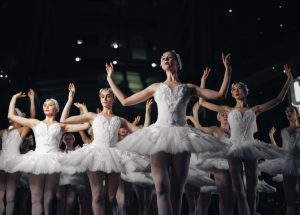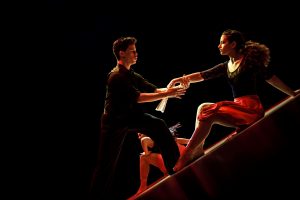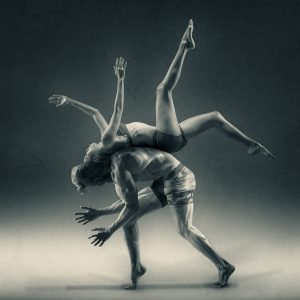Arts Alive provides many online educational resources for those interested in the arts. They even have a selection of resources that describe different approaches for choreographing and what elements might be used in the creation of a dance. The articles that the organization provided agrees with the previous resources that I have discussed. They also state that choreographic processes and approaches are dependent on a choreographers artistic style, vision, and outside resources.
Further, many choreographers choose to work in different situations such as various different environments and work settings. Some may choose to work independently and hire dancers and artists on a occasional basis depending on the project and style that the choreographer is working on. Some may work for a company that is based on creating choreographic visions. Others may work as a artist in residence or an artistic director for companies and studios that study repertoire. Some choreographers may also be invited into companies all around the world as artistic guests to allow for artistic development within a studio or company or to provide new experiences for residents.
As discussed in the article by the Knight Foundation, Arts Alive also describes the choreographic approach for contemporary dance as a more exploratory and experimentation based development of movement. It also agrees with the Britannica’s idea on the Three Phase process where artists who work with traditional or more classical genres of technique such as ballet or tap opt to work within a set technique or movement style to initiate their piece. They may then choose to stay within the technical limits or expand or build upon them to create something new under their influence. Here, a choreographer may combine traditional technique along with their own personal movements in order to portray their final vision.

Arts Alive also provides a toolbox of elements that choreographers may look to in order to develop their dance.
1. Shape
- Shape refers to the pathways and positions the body takes within a movement or a phrase. Shape concepts to explore include:
- Levels – movements can be performed at different levels such as high or low in space.
- Symmetry and Asymmetry – used to create different effects with the body. Symmetry occurs when the left and right sides of the body mirror each other and appear identical. Asymmetry occurs when the right and left sides of the body engage in different movements and appear unbalanced.
- Scale – “Positions and movements can be performed on a small to large scale. In small-scale actions, the limbs and torso are drawn inward: they contract, flex, fold and bend. In large-scale actions, they extend and stretch out to their fullest length. Think of contrasting shapes that are angular-curved-straight, shrinking-expanding or contracted-extended (Arts Alive, The choreographer’s Toolbox)”.

2. Space
- Space refers to the pathways, patterns, and the amount of space that a dancer takes up during a movement or phrase. Space concepts include:
- Geometric forms – this could include the spacing or shape that the dancers make within a piece wether it be a straight horizontal or vertical line extending from wing to wing or upstage to downstage. This could also include the use of pathways whether they be curved, spiraled, or zig – zagged, etc… This may also include the use of vertical space through the use of jumps or lifts.
- Symmetry and Asymmetry – used to create various performance affects as dancers move through the space symmetrically or asymmetrically to create a dramatic effect.
- Scale – how much of the stage os used. The performance area can be small or large. and the choreographer can choose how much of the area they would like the dancers to encompass.

3. Timing
- The speed dynamics of a dance and how the choreographer puts movement to music.
-
- Tempo – slow or fast. May be steady or consistency changing. Tempo in dance is referred to the same as in music (allegro, adage, accelerando, ritardando).
- Metre – “Metre refers to the organization of beats into bars with strong accents on the downbeat followed by lighter accents. In musical terminology this is called the time signature. Dancers sense metre as a recurring rhythmic underpinning. In dance we talk of movement phrases, which dancers may or may not count in musical beats corresponding to bars. Basic time signatures include: 2/4 (” 1, 2 “) ; 3/4 (” 1, 2, 3 “) ; 4/4 (” 1, 2, 3, 4 “) ; and 6/8 (” 1 and a, 2 and a “). While ballet commonly uses regular time signatures, modern dance often uses irregular ones like 5/4 (” 1, 2, 3, 1, 2 “) ; 7/4 (” 1, 2, 3, 4, 1, 2, 3 “) ; and also changing metres. (Arts Alive, The choreographer’s Toolbox)”
- Rhythm – The patterns and beats that dancers follow. Some choreographers will use these beats as accents to give the movements more dynamics.

4. Dynamics
- dynamics refers to the quality of movements and how the choreographer uses all the elements to create dramatic effects and support the artistry of the dancer.
- Weight – how the dancer holds their body and how they approach movement. Can be heavy/strong or light/soft.
- Time – The effect of time on a movement. Can be sustained or instant/ sharp.
- Space – how the dancer moves toward a new movement (indirect or direct).
- Flow – can be free movement or limited. A limited movement is often concise and specific while a free movement is more unpredictable.
Information and research retrieved from:
http://www.artsalive.ca/en/dan/make/process/ways.asp
http://www.artsalive.ca/en/dan/make/toolbox/elements.asp
Written and provided by: Arts Alive. ca and theNational Arts Centre
Retrieved on: February 18th, 2020
Enjoy this video on the elements of Dance!
I find this outline of elements really helpful. Sometimes it is hard to decide what dynamics can be applied to create a desired affect while creating a dance. It is useful to have suggestions listed it out to remind you of the possibilities that you can engage in.

Leave a Reply
You must be logged in to post a comment.